

The Intelligence of Plants. Plants For A Future : 7000 Edible, Medicinal & Useful Plants. Joseph Simcox Rare Vegetable Garden Tour Part 1. Botanical Explorers: The Fruitful Forest (Full Movie) Pascal Poot, l'homme qui fait pousser 400 variétés de tomates sans eau ni pesticides. Dans l'Hérault, Pascal Poot a développé une méthode qui lui permet aujourd'hui de cultiver et de sélectionner quelques 400 variétés de tomates bio sans arrosage ni utilisation de produits phytosanitaires.
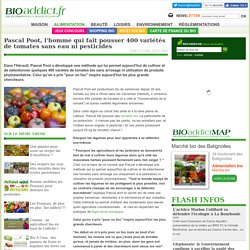
Celui qu'on a pris "pour un fou" inspire aujourd'hui les plus grands chercheurs. Pascal Poot est producteurs bio de semences depuis 20 ans. Installé sur 3ha à Olmet dans les Cévennes (Hérault), il conserve environ 450 variétés de tomates (il a créé le "Conservatoire de la tomate") et autres variétés légumières anciennes. Dans cette région au climat très aride et à la terre pleine de cailloux, Pascal fait pousser des tomates bio. La particularité de sa production : il n'arrose pas les plants, ne les entretient pas, et n'utilise aucun engrais ni pesticide ! Eduquer les légumes pour leur apprendre à se défendre eux-mêmes Celui qu'on a pris "pour un fou" inspire aujourd'hui les plus grands chercheurs Des stages ouverts à tous pour apprendre à cultiver légumes et fruitiers bio sans eau. Tomaten-Atlas - Sorten. Hier ist eine Übersicht über alle Sorten.
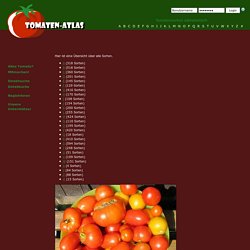
Tomates sans eau ni pesticide : cette méthode fascine les biologistes. Tomato Leaves: The Toxic Myth. Maybe it was my Asian upbringing that taught me never to waste food, as my family used and ate every part of the vegetable, fish, chicken, pig or cow that we brought home.
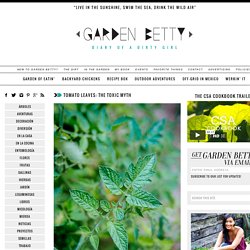
Or maybe it’s my ever-growing curiosity when it comes to food from the land… but when I walk around the garden, looking at all my lovely plants, I always think, Can I eat that part? And by “part,” I mean the unconventional parts of the plant that you typically don’t think to eat. This was how I came to love artichoke stems, leek greens, and cucumber leaves, parts that are normally discarded or composted, but are in fact quite tasty. Wussten Sie schon, Sie können Kürbis Blätter essen? / salemcoc.com. Wenn es um die Gartenarbeit, habe ich eher ein Händchen für das Töten von Pflanzen als die Herstellung jeder Art von erfolgreiche Ernte.

Als solche hat sie mein Mann widerfahren bis zur vollständigen Aufladung der dazu neigt, unsere Sommergarten zu nehmen, und seinen wertvollen Pflanze ist das riesige, enthusiastisch Kürbis Rebe. Seine Produkte werden von der Halloween schnitzen Sorte, nicht so toll zum Essen. These amazing trees grow up to 40 different types of fruit. In all the time I’ve spent cruising around my quiet Seattle neighborhood for fallen sidewalk fruit (the semi-bruised apples are delicious), I’ve never thought to myself: “Geez.
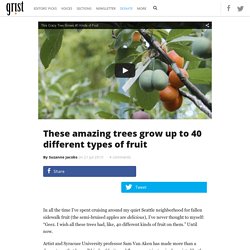
I wish all these trees had, like, 40 different kinds of fruit on them.” Until now. 40 Fruits, vegetables and herbs that will grow in partial shade - Mankato Green Culture. Perennial Vegetables: Years of Bounty. Perennial vegetables—crops that you plant just once and harvest year after year—are relatively rare in North American gardens.
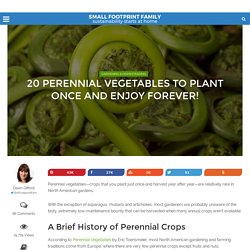
With the exception of asparagus, rhubarb and artichokes, most gardeners are probably unaware of the tasty, extremely low-maintenance bounty that can be harvested when many annual crops aren’t available. A Brief History of Perennial Crops According to Perennial Vegetables by Eric Toensmeier, most North American gardening and farming traditions come from Europe, where there are very few perennial crops except fruits and nuts. Cold and temperate Eurasian agriculture centered around livestock, annual grains and legumes, and early European settlers to North America simply brought their seeds and their cultivation methods with them, including draft animals for plowing up the soil every year.
However, in more temperate and tropical areas of the world, including much of North America, perennial root, starch and fruit crops were actively bred, selected and cultivated. 11. Digging Deep Reveals the Intricate World of Roots. If you’ve ever driven past wild prairie grasses swaying in the Kansas breeze and felt a wave of appreciation for America’s heartland, you should know that those visible grasses are just the tip of the iceberg.

“We’re pretty blind to what’s going on beneath the soil,” says photographer Jim Richardson, who became well acquainted with the world of dirt while working on “Our Good Earth,” a 2008 National Geographic magazine story. The bulk of a prairie grass plant, it turns out, exists out of sight, with anywhere from eight to fourteen feet of roots extending down into the earth. Why should we care? Besides being impressively large, these hidden root balls accomplish a lot—storing carbon, nourishing soil, increasing bioproductivity, and preventing erosion.
A Global Wiki of Perennial Crops, Polycultures, and Food Forest Sites. Designing perennial polycultures (guilds) can be a big challenge.
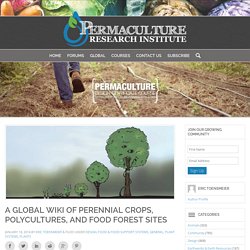
It can be hard to find information on perennial crops and support species. There is a need for information, sample polycultures, and design templates. The Apios Institute is a collaborative network of farmers, gardeners, and researchers focused on integrated perennial-crop agroecosystems (variously known as multistrata agroforests, tropical homegardens, food forests, and forest gardens). Since 2007 we have worked to address these key needs on our site, a crowdsourced tool featuring perennial crops, polycultures, and food forests. Yacon Movie! A Permaculture planting of a tropical plant in a cold climate. Plant These Plants Once & Harvest The Rewards For Years… Year after year we start seeds, till the ground, plant, weed, harvest, then tear it all out at the end of the season.

It’s a lot of work, no doubt. Permaculture Gardening - Spring time with Patrick Whitefield. Mahonia bealei Leatherleaf MahoniaMahonia on PlantPlaces.com. Common Name: Leatherleaf Mahonia Latin Name: Mahonia bealei Size: 3 (min) to 6 (max) Are you looking for this plant?
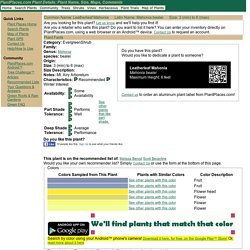
8 global crops for your edible garden. Get Acquainted with 5 Common Backyard Weeds with Remarkable Healing Properties. Although you may already be familiar with many of your neighborhood “weeds” and their myriad uses (such as using dandelion leaves in salad), it’s quite possible that you pass by several other important plants on a daily basis, completely unaware of their awesomeness. Those listed below are usually torn from manicured gardens because some people believe that they’re not as refined or pretty as peonies or hollyhocks, but their healing properties are so spectacular that they should earn a place of esteem amongst the most prized rose species. Take a look at these humble little plants, and if you find them popping up around your own yard, maybe you’ll find a new appreciation for them.
Yarrow Commonly considered a weed and often ripped out of cultivated gardens everywhere, yarrow (Achillea millefolium) might not be the prettiest or most graceful of flowers, but it’s been used medicinally for thousands of years. Related: DIY – How to Make Your Own Herbal Tinctures. Jamaicathymian, grün (Pflanze) - Coleus amboinicus. Trees - Words by Hermann Hesse. Förster & Autor Peter Wohlleben. Peter Wohlleben im Interview: Wenn Bäume miteinander sprechen. Bäume sprechen miteinander. BBC How Plants Communicate & Think - Amazing Nature Documentary. What Plants Talk About - Documentary. Hermann Hesse on What Trees Teach Us About Belonging and Life. I woke up this morning to discover a tiny birch tree rising amidst my city quasi-garden, having overcome unthinkable odds to float its seed over heaps of concrete and glass, and begin a life in a meager oasis of soil. And I thought, my god*, what a miracle.
What magic. What a reminder that life does not await permission to be lived. This little wonder reminded me of a beautiful passage by Hermann Hesse (July 2, 1877–August 9, 1962) — one of the most beautiful I’ve ever read — from his 1920 collection of fragments, Wandering: Notes and Sketches (public library). Asimina triloba 'Wells Grafted' Wells Grafted Pawpaw from Forrest Keeling. Image 1 of 3 Wells Pawpaw produces fruit that weigh one pound or more.
Wells Grafted Pawpaw. PawPaw-Info.de - Sortenübersicht - PawPaw-Sorten. Temperate Climate Permaculture. Your source for Permaculture design in a Temperate Climate! Pfirsich Flamingo » Die wichtigsten Infos zur Sorte.
Maulwurfabwehr - Goldlauch - Allium moly. Quoi cultiver à l’ombre ? Qui dit potager dit généralement soleil… voici quelques solutions pour jardiner si celui-ci n’est pas au rendez-vous. La plupart des légumes exigent de 6 à 8 h de soleil par jour pour bien pousser. Si votre parcelle ou votre balcon en reçoivent de 4 à 6 h, ce sont des conditions de mi-ombre qui permettent néanmoins certaines cultures (présentées ci-dessous). Avec moins de 4 h, les chances de réussite sont limitées mais la chaleur peut parfois compenser… alors si le jardinage vous démange, pourquoi ne pas essayer ? Bonnes nouvelles pour les jardiniers de l’ombre : un tel potager demande moins d’arrosage et les laitues, épinards et roquettes ont peu de chance de monter en graines sous l’effet de la chaleur… À vos truelles : le tableau n’est pas si sombre !
Green Grafting - Heritage & Rare Fruit Network. One Man’s Genius Idea To Grow Tomatoes. [Via realfarmacy.com and hometalk.com] James Bryan had a bright idea that resulted in something brilliant. Gardeners and repurposing fanatics behold, keyhole garden, meets tomato cage, meets drip irrigation. The setup is obviously simple yet highly functional and effective. Identifying Plant Nutrient Deficiencies - Permablitz Melbourne. Not all plant problems are caused by insects or diseases. Sometimes an unhealthy plant is suffering from a nutrient deficiency or even too much of any one nutrient. Plant nutrient deficiencies often manifest as foliage discoloration or distortion. The following chart outlines some possible problems. Unfortunately many problems have similar symptoms and sometimes it is a combination of problems. Be sure you eliminate the obvious before you kill your plants with kindness.
Check first for signs of insects or disease.Foliage discoloration and stunted plants can easily be caused by soil that is too wet and drains poorly or soil that is too compacted for good root growth.Extreme cold or heat will slow plant growth and effect flowering and fruit set.Too much fertilizer can result in salt injury.
Plants require a mix of nutrients to remain healthy. There are a handful of additional nutrients that are required for plant growth, but in much smaller quantities. Rare Heirloom Seeds. Food Forest Farm and Permaculture Nursery - Home. Boomkwekerij De Acht Plagen Friesland. Boomkweker Arie Bruin. Specialist in kweken van Juglans, Carya, Diospyros, sharonfruit, persimoen. Kweker enter, enten. Supplement D - L. J. L. Se977. Deaflora. Deaflora - Ihre Aromagärtnerei. Über 2000 Pflanzen und Samen.
Alle Pflanzenraritäten können Sie direkt in der Gärtnerei in Werder (in der Nähe von Potsdam und Berlin) mitnehmen oder im Shop für den Versand in Deutschland und in der EU bestellen. Saatgut online kaufen: Geheimtipps mit tollen kleinen AnbieternDer Selbstversorger. Im heutigen Artikel möchte ich mich mit dem Thema Saatgutkauf befassen und einige potentielle Bezugsquellen für altes und biologisches Saatgut auflisten. Vorneweg: Ich mag den Begriff “Bio” nicht, es versteht sich von selbst, dass ich bei der Auflistung darauf achte, dass die Händler frei von Gentechnik sind und ihre Pflanzen auch nicht mit Pestiziden o.Ä. behandelt haben. Rühlemann's Kräuter und Duftpflanzen. Arche-noah.at - Saatgut Übersicht. Logee’s Plants for Home & Garden. Winterharte Stauden. Nachfolgend finden Sie Pflanzen mit essbaren Teilen (z. B. Nutzpflanzenvielfalt.de. Linkliste: Wo gibt es alte Gemüse-Sorten? Stand: 20.05.2016 15:25 Uhr - Lesezeit: ca.1 Min.
Saatgut von alten Sorten und Informationen über den Gemüse-Anbau liefern zahlreiche Vereine und Initiativen im Internet. Dreschflegel-Bio-Saatgut - Direktversand - Ziele Ökologie und Politik - Betriebsstruktur. Giersch bringt Vitamine, Mineralien und Abwechslung auf den Teller. Wildgemüse ist meist vitamin- und mineralstoffreicher als Kulturgemüse, wächst üppig und ist überwiegend schneckenresistent. Außerdem steht es jedem kostenfrei zur Verfügung, der sich damit beschäftigt und die Augen offen hält. The Secret to Huge Potato Harvests. Nachgemacht: Radieschenblätter-Pesto. Hochbeet und Frühbeet Ursula – Spitzenqualität aus Österreich - Informationen rund um das Thema Hochbeet aus Metall.